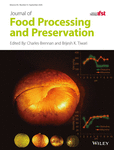Siriguela peels provide antioxidant compounds-rich extract by solid–liquid extraction
Abstract
This work aimed to extract antioxidant compounds from siriguela peels. For that, operational conditions of ethanol percentage and solid/liquid ratio (w/v) were defined based on a rotational central composite design. The extracts were evaluated for the determination of total phenolic compounds (TPC) and antioxidant capacity by ABTS•+, DPPH•, and FRAP methods, and under best operational condition, UPLC-qTOF/MS analysis was also performed. The best operational condition for antioxidant compounds recovery was that using 30% ethanol and solid/liquid ratio of 1:33. Under this condition, TPC, ABTS•+, DPPH•, and FRAP values were 1611 mg GAE 100 g−1, 103 µmol TE g−1, 102 µmol TE g−1, and 534 µmol Fe2+ g−1, respectively. The extract was major composed of quercetin derivatives. Therefore, siriguela peels are a potential source of antioxidant compounds, which expands the use of this residue by the food industry and can also mitigates environmental impact caused by its inappropriate disposal.
Practical applications
Findings of the present work show that siriguela peels are a source of antioxidant compounds. After the evaluation of the extraction process, an extract major composed of quercetin derivatives was obtained. This extract could be used in future applications for the development of natural preservatives as well as functional food products. Also, the extraction method evaluated in this work presents low cost, which becomes this approach a potential alternative to add value to agro-chain of other species of the genus Spondias.
CONFLICT OF INTEREST
The authors have declared no conflicts of interest for this research article.




